Memories of Yesteryear
Part 4
Motorcycling: Post Great War era (1920-1925)
Like it or not, there is nothing like war, however unfair and murderous, to advance technology. This is unfortunately as true today as it was 100 years ago in terms of the motorcycle evolution after the Great War.
The war revealed the usefulness of motorcycles, recognising them as practical and relatively reliable. This, together with the increasing popularity of competition motorcycling in the early 1920s, thanks to further improvements in reliability and handling, led to more advances on the technical front.
I would love to go into greater documented detail on this fascinating period, but the aim of this article is to present a more visual record, which I hope you will agree is more interesting than straightforward facts and figures; allowing me to share a greater number of photos in the limited space available.
In a nutshell, let's summarise a few highlights from the 1920s:
- George Brough, the second son of motorcycle pioneer William Edward Brough, set up his own factory in Nottingham in 1919 to produce what he called the Brough Superior range of motorcycles and motor cars. He brought together the best components he could find and added distinctive styling details and in 1922, he rode a Brough Superior SS80 managing an unofficial 100 mph (160 km/h) lap of Brooklands.
- The industrial production of motorcycles was dominated by England, but by 1920, Harley-Davidson became the largest manufacturer worldwide with their motorcycles being sold through dealers in 67 countries. DKW in Germany took over as the largest manufacturer in the late 1920s.
- BMW motorcycles came on the scene in 1923 with a shaft drive and an opposed-twin.
- As motorcycles got faster, the need for protective clothing grew, and many bikers turned to the thick leather horsehide of World War era of military overcoats. In 1928, Irving Schott, a jacket maker in New York City, created the first leather jacket specifically for motorcycling, named after his favourite cigar: The Perfecto.
Now let me share the photographs I have picked out to illustrate this golden age of motorcycling in Europe in the 1920s.
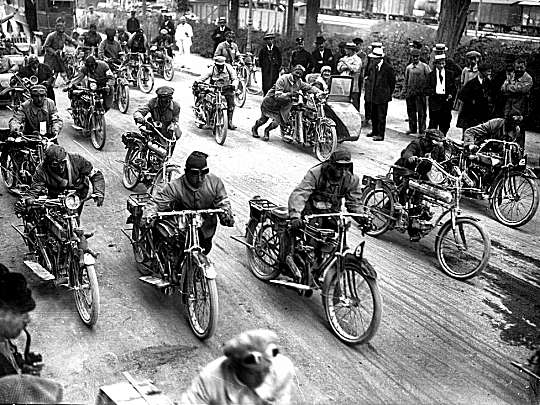
1919 - In Germany, solo and outfit racers on the starting line, preparing to set off in a competition
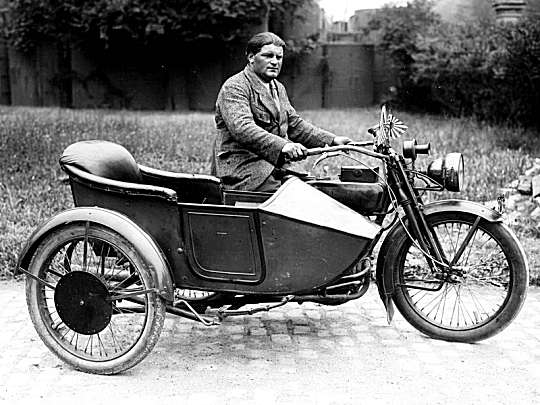
1919 - Mr. Blauseur on Harley-Davidson 1000, one of the competitors of the 'Paris-Reims-Paris' race. This first great post-war race of 310 km was held on July 6, 1919
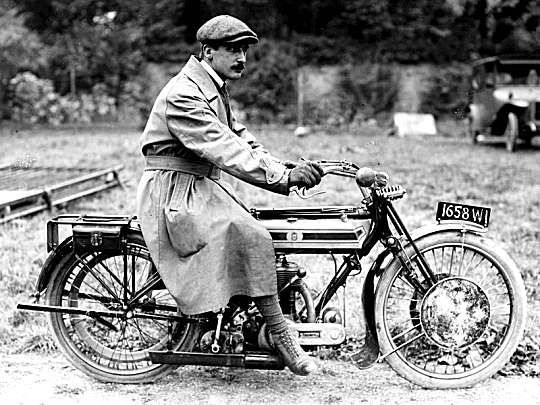
1919 - Mr. Martinez on Triumph 750 cm, another competitor in the 'Paris-Reims-Paris'regularity race. Martinez did the entire route with admirable regularity and should have won his category. But as a gentleman he lent a hand to a colleague in difficulty with his car, fell behind, was penalised, and therefore lost the race.
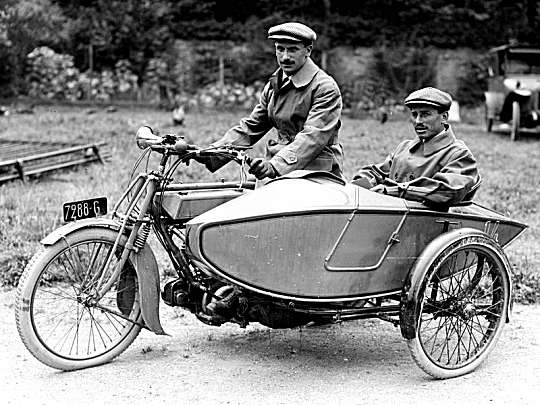
1919 - Paul Pean on Peugeot at the 'Paris-Reims-Paris' race. Peugeot entered its name in this event by entering only one machine. Their confidence in the reliability of their machine was justified since Paul Pean finished 1st equal in his category without any penalty. Hutchinson, the ace of motorcycle tyres, was the big winner since, except for one category, it won all the others
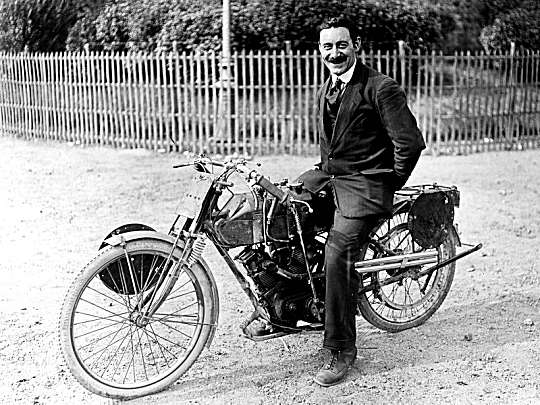
1920 - Mr. Milland on Motosacoche, at the Circuit de la Sarthe (aka Le Mans).
This first race was held in 1920, when the UMF (Union Motocycliste de France) organised a motorcycle grand prix on a triangular course from the Pontlieue suburbs of Le Mans, along public roads to Mulsanne and back again. In total the circuit measured more than 10 miles and proved a machinery-breaker. Of the 31 starters, only 4 were still running at the end.
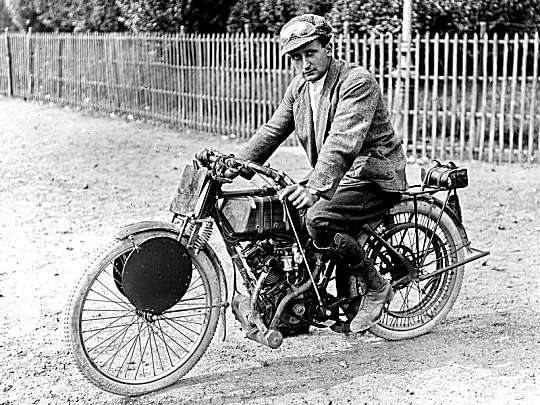
1920 - Mr. Robert also on Motosacoche, at the Grand Prix of the Circuit de la Sarthe
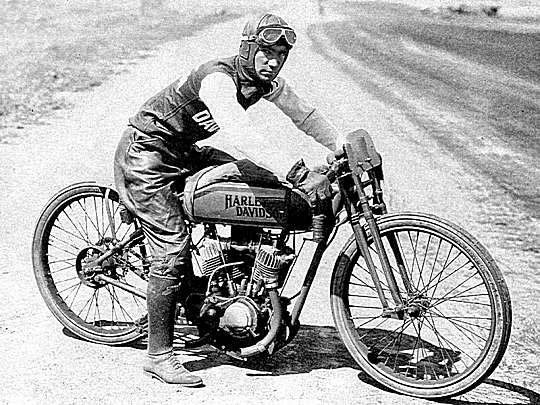
1920 - Jim Davis, winner on a Harley-Davidson of the 1920 Dodge City 300 mile race on July 4,1920. Davis started riding motorcycles at age 11 and earned his first factory ride with Indian at age 19 in 1915.
One of the bravest racers, he won 21 American Motorcycle Association National Championships — including the first race ever sanctioned by the AMA at Toledo, Ohio, on July 26, 1924 — and more than 50 non-AMA titles. It's a record that will never be equalled.
By the time Davis retired in 1936 he had raced in more than 1500 events, and covered an astounding 30,000 competition miles. Not only did he survive the board-track era, he survived to see the 21st century, passing away on February 5, 2000, at the age of 103
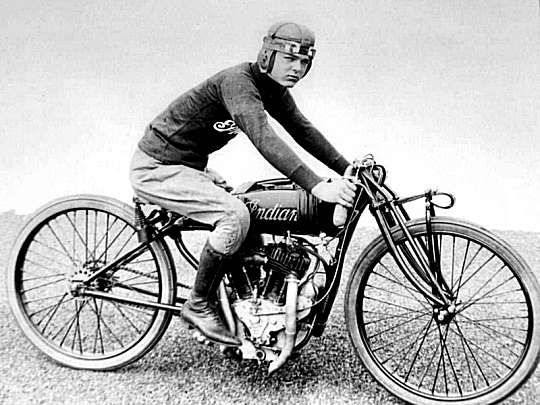
Henry Hammond Springs of Atlanta, GA., photographed here at the Indian factory in Springfield, Massachusetts, was a top rider at Indian, a local hero in Atlanta, and a crowd favourite. He became an official member of the Indian factory team at 17, competing across the USA in the major events of the day.
Hammond was another remarkable young talent who dedicated his life to racing motorcycles, and like so many competitors from that time he too tragically gave his life in the pursuit of victory. He was injured in a racing accident at South Bend, Indiana on May 30, 1922 and died the next day.

1921 - Mr. Dooer on Motosacoche at the 'Paris-Nice' regularity race, one of the 93 competitors representing the biggest French, Belgian, English, Italian and American brands.
The first edition of the 'Paris-Nice' dates from the spring of 1913. It was renewed the following year, before being brought to a halt because of the war, and did not resume until 1920. This French popular event, open to motorcycles, sidecars and cyclecars, was contested in four stages, starting from Montgeron in the department of Essonne, bound for Dijon, then Lyon, Marseille and Nice (a total distance of 1,200 km)
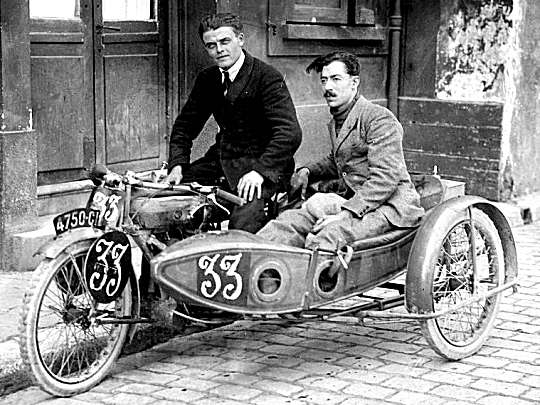
1921 - Grand Prix de France in Provins - Raymond Guiguet on Orial.
The first French Grand Prix was organised in August 1912 in Fontainebleau by the Motocycle Club de France (MCF). The race was run in 1913 and 1914, then brought to a halt until May 1920 when the French Grand Prix returned to Fontainebleau. In 1921, the MCF left the traditional circuit of Fontainebleau for that of Provins. The Grand Prix displayed 5 different categories: 250cc, 350cc, 500cc, 600cc sidecars and 1000cc sidecars
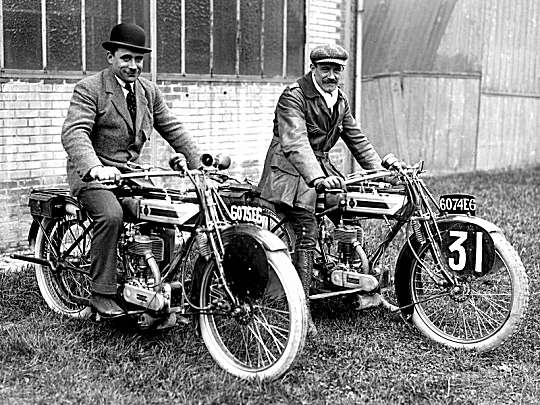
1921- The Sarolea team: Mr. Duverne and Mr. Lefevre, at the regularity race of Marly-le-Roi, organised by the Union Motocycliste of France
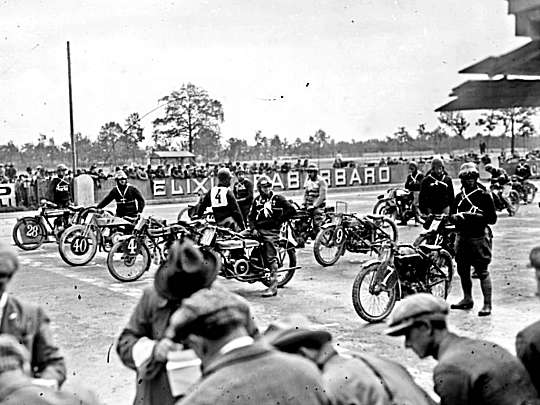
1922 - Start of the 500 cc race at the Grand Prix of Nations at the Monza circuit, Italy.
Construction of the Monza Autodrome was started in January, 1922, by the Milan Automobile Club to mark the 25th anniversary of the club's founding. The track was officially opened on a rainy 3 September 1922. This was followed on 8 September by the motorcycle Grand Prix of Nations with overall factory honours going to Amedeo Ruggeri on a Harley Davidson 1000 and Gnesa with a 2- stroke Garelli 350 in the 500 class.
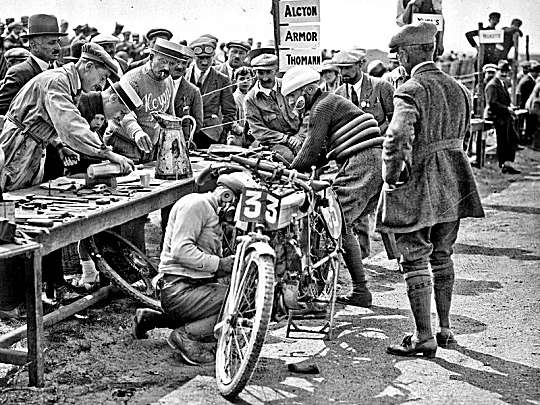
1922 - Mr. Meunier sur Alcyon at the Grand Prix de France in Montargis, in June 1922. It's interesting to note the extraordinary set up of the pit stop and the outfits of both the racer and his team!
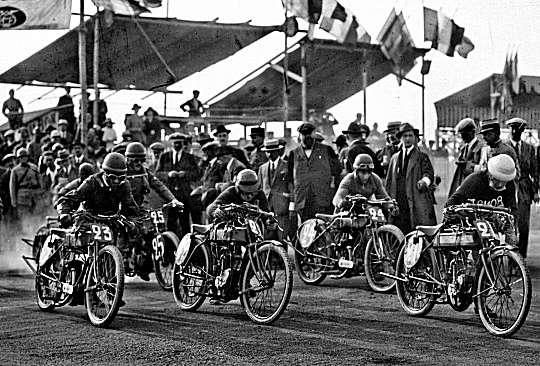
1922 - Start of the 250cc (10.83 km x 30 laps) at the French Grand Prix organised by the MCF on June 5, 1922 at the Montargis circuit
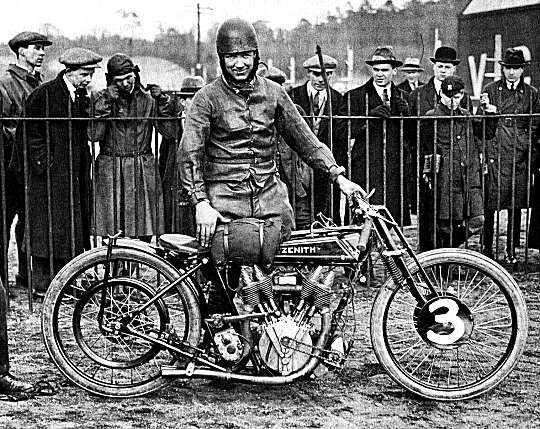
1922 - On 27 October Bert Le Vack made history by lapping Brooklands at 100.29mph on this 980cc Zenith. Nicknamed the 'Wizard of Brooklands', he gained recognition for his victorious exploits as a racer around the famous Brooklands track.
His victories saw Le Vack's reputation rise stratospherically, becoming widely regarded as one of the best motorcyclists of his generation. He was also a leading tuner who developed a complete range of world beating engines from 250cc to 1000cc. He used these engines in a range of machines, which included Brough Superior, Zenith, New Imperial, Coventry Eagle and HRD.
He was killed while riding a Motosachoche sidecar outfit on the public road in Switzerland in 1931
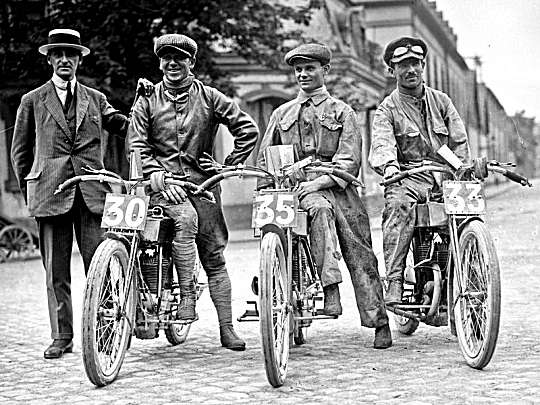
1922 - Italian racers at the 'Grand Prix de Strasbourg'. From left to right: Gnesa on Ermino, Visioli on Ottorino and Dall'Oglio on Garelli.
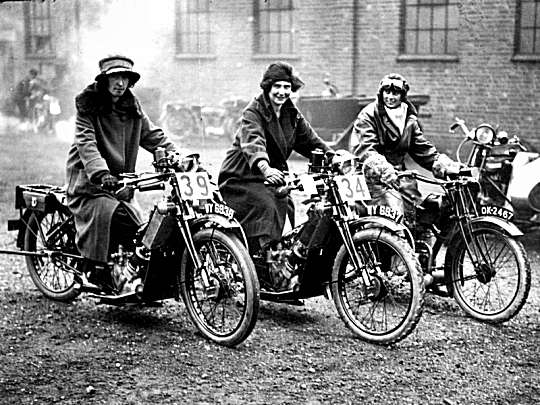
1923 - Women and their rides at the 1923 ACU Trials in Birmingham, England
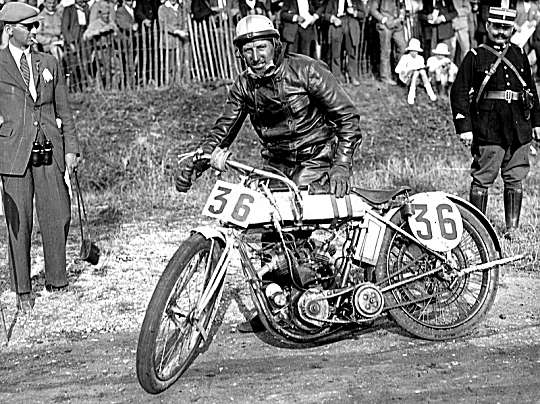
1923 - Mr. Marc sur Alcyon, winner of the 350cc category at the 1923 French Grand Prix at the Montargis circuit
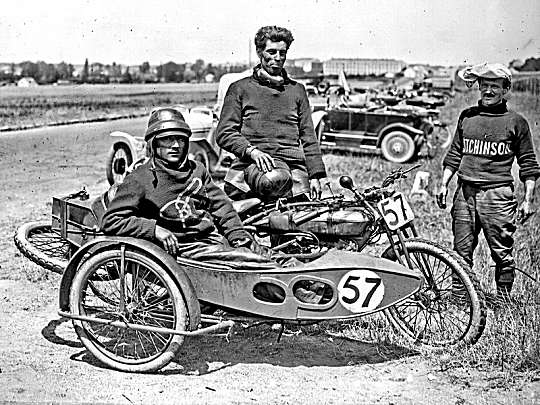
1923 - Alexandre Hommaire on Orial, competitor in the 600 cc sidecar category at the Grand Prix de France in Montargis
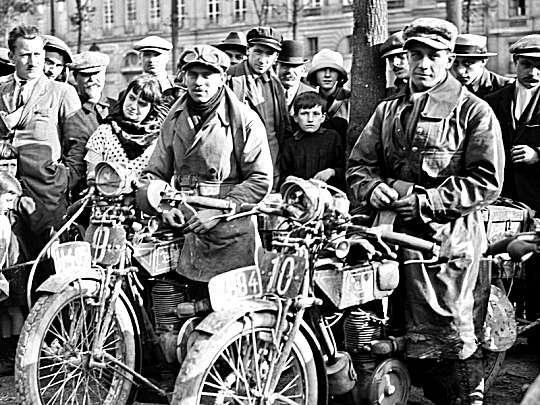
1923 - Hufkens (left) and Reynartz (right) on Gillet motorcycles at the start of the classic regularity race 'Paris - the Pyrenees - Paris', organised by Moto-Revue with the help of the newspaper 'Petit Parisien'. Thirty-five motorcyclists took part (2 mopeds, 16 motorcycles, 2 sidecars and 15 cyclecars) amongst them Robert Sexe on Norton who finished in 3rd place in the 500cc category.
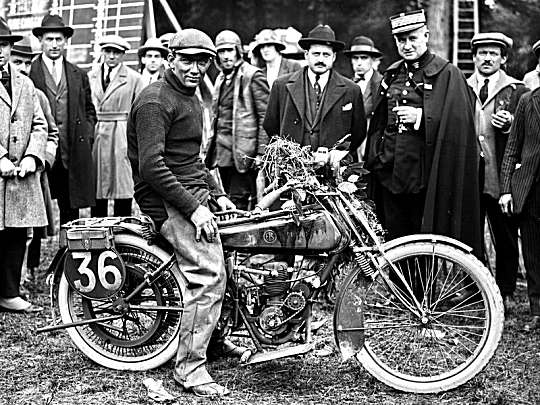
1923 - Francois Clech on Motosolo during the second Bol d'0r at the Loges circuit in the forest of St Germain.
The Bol d'Or, an endurance motorcycling competition created by Eugene Mauve in 1922 as part of the Association of Former Military Motorcyclists (AAMM) is reputed to have been the first 24-hour race in the world.
Francois Clech, born in 1895, fought in the 1914-18 war as a military dispatch rider on a Clement, which was probably requisitioned. After the war, he joined Motosolo, a small manufacturer, and entered the competition in 1919.
He won the Bol d'or in 1922 and 1923 in the 250cc category and was crowned 1923 French champion in that same category. A fall in January 1928 during the Six Days of Winter left him with an arm injury too crippling to continue his racing career.
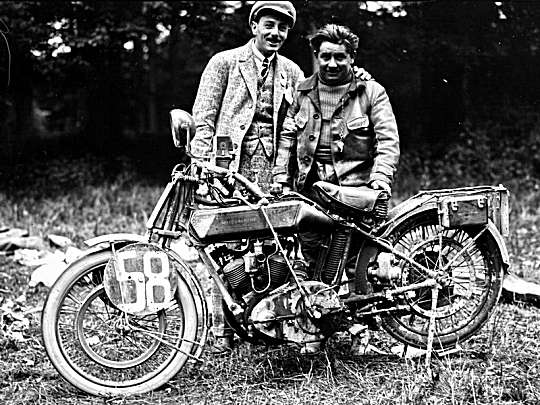
1923 - French motorcyclist rider Tony Zind (right), winner on Motosacoche of the 500cc category of the Bol d'or 1922 and 1923
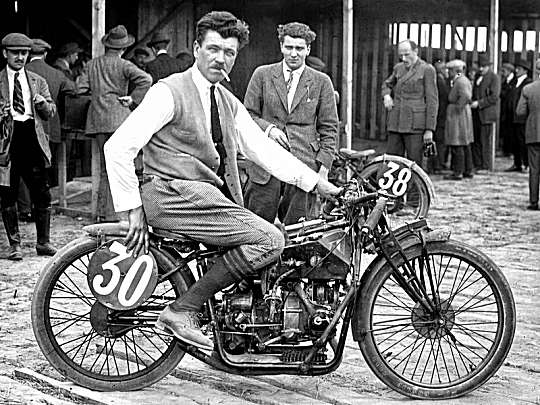
1923 - Henry Naas on Gnome-Rhone 500cc at the circuit de Tours (22.830 km) during the 4th Grand Prix of the UMF.
British riders won the first places in the GP three categories: Geoff Davison on Levis in 250cc; Frank Longman on AJS in 350cc; and Jim Whalley on a Douglas in 500cc
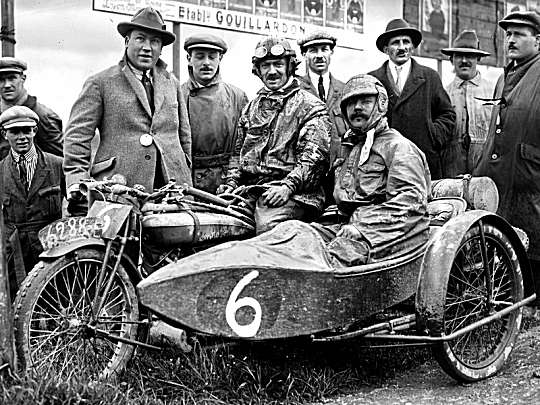
1923 - Moret (left) and his passenger, winners on Orial of the 600cc sidecar category of the 13th Grand Prix de Lyon, at the Saint-Andre-de-Corcy circuit. Oddly, no competitor in the 1000cc sidecar category actually reached the finish line
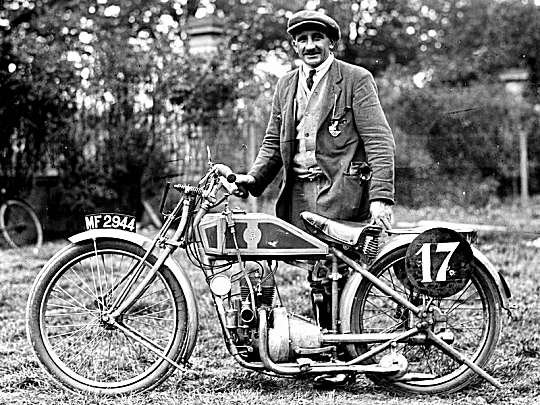
1924 - Lambert on B.T before the start of the 3rd Tour de France.
Organised by the Motocycle Club de France since 1922, this great regularity competition was contested over nearly 4,000 kilometres on a course around the country, to be covered in sixteen consecutive days.
Everywhere, the populations of the towns and villages were there to cheer and watch the competitors passing through on their machines. This demonstration proved to be excellent PR, demonstrating to the public the use of the motorcycles of the day on a daily basis as a means of reliable transport. Of the 38 competitors at the start of the Tour de France 1924, 31 finished the race. These machines that had completed the parcours were on display for the public for several days in Paris.

1924 - A female motorcyclist, Mlle Dupre, at the start of the regularity race 'Coupe de l'Armistice' (created in 1922) at the Joinville-Versailles circuit

1925 - Motorcycle chariot racing existed as a motor sport in the 1920s and 30s.
It had been inspired by the 1925 American silent epic adventure-drama film 'Ben-Hur', although it was largely, (although not entirely), forgotten after that.
The chariots were made from wine barrels with automobile wheels attached to them with motorcycles in front and 'Charioteers' wearing Roman era inspired costumes with motorbike riders in front who drove them during the race.
As the sport evolved, more than one motorcycle was attached to the chariot and was driven by the 'charioteer' himself instead of a rider which must have been challenging to control using just a pair of reins, seemingly simply made of leather. One method must have been to attach each rein to each individual motorcycle's throttle, allowing the racer to steer the chariot by controlling both motorcycles simultaneously at various speeds. Some riders took daring risks in riding three motorcycles attached to the chariot.
- Jean-Francois Helias